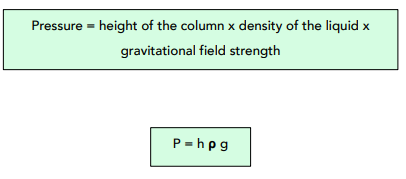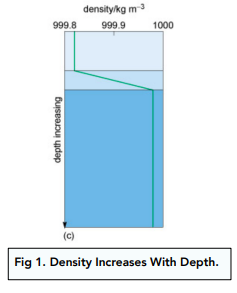Fluid Pressures Part 2 (GCSE Physics)
Fluid Pressures Part 2
Calculating Pressure in Liquids
Previously, we discussed a generic formula for calculating the pressure of a fluid. Now, we are going to look at the formula for calculating the pressure of a specific fluid – a liquid. The equation will actually determine the pressure at one point in the liquid.
Formula for Pressure in a Liquid

Where:
- pressure, p, in pascals, Pa
- height of the column, h, in metres, m
- density, ρ, in kilograms per metre cubed, kg/m³
- gravitational field strength, g, in newtons per kilogram, N/kg
Question: Olivia is filling a large tank with water (density 1000kgm-3) . What is the pressure in kPa due to the water at a depth of 5m?
The value of ‘g’ is 9.8 Nkg-¹.
- Write out the equation.
In this question, we are going to use the following equation:
- Substitute in the numbers.
We know the values for density, the height of the column and the gravitational field strength.

Pressure Increases in Liquid
- Density describes the ‘closeness’ of particles. When we talk about density in a liquid, we are referring to how closely together the particles are placed. The closer together the particles are, the denser the liquid is.
- Density is measured at one point. In a liquid, density if measured at one particular point. This means that within one liquid, there can be various different densities.
- Density increases with depth. The deeper down into the liquid we go, the higher the pressure will be. This is because there is the pressure of the mass of water particles above up pushing down, so the deeper the level, the more particles there are above.


Differences in Pressure
We already know that there can be different pressures within a single liquid. This means that we can calculate the differences in pressure at different depths in a liquid.
Question: Emily has a container full of water (density 1000kgm-3). She wants to know the pressure difference between two points in the container; 3m and 7m. Calculate the pressure difference and give units.
The value of ‘g’ is 9.8 Nkg-¹.
- Write out the formula.
We need to use the formula from the previous section, to calculate the pressures at both points in the liquid.

- Substitute in the numbers.
We need to calculate the pressures at both points in the liquid.
- Calculate the difference.
Now that we have the two difference pressures, we can use take one away from the other to find the difference in pressure.

Hydraulic Systems
A hydraulic system uses a liquid to transmit a force.
Generally, two pistons are connected by a tube filled with a liquid and the pressure is constant throughout the whole system. A force is applied to one piston, pushing it downwards. This force is transmitted to the other piston, pushing it upwards. This is seen in hydraulic brakes on cars.
The diagram shows the same concept, but instead from a small cylinder to big cylinder. A small force on a smaller area is able to produce a greater force on a larger area.

We use liquids as they are harder to compress than gases, meaning the they are better at transmitting a force.
Submerged Objects
Upthrust

- Submerged objects displace fluids. When objects are submerged into fluid, they will displace the fluid. In other words, we can say that when an object is placed into a fluid, the fluid can ‘move out of the way’ of the fluid.
- Fluids exert pressure on submerged objects. A submerged object experiences a pressure when placed into a fluid. This pressure is due to the fluid exerting forces on the object from every direction.
- Forces acting at the top and bottom of a submerged object are different. Forces acting on the bottom of the submerged object are greater than those acting on the top of the object. This means that the pressure is higher on the bottom of the object compared to the top. This can be explained by a concept we explored previously; the deeper we go into a liquid, the higher the pressure becomes.
- All the forces will combine to form an upthrust force. Since the object is experiencing various forces, they will all combine to form one resultant force. This force is called the upthrust.
Floating and Sinking
When we look at whether an object will float or sink, we consider two main factors.
- Density of the object – if an object is more dense than the fluid displaced, it will sink. If an object is less dense than the fluid displaced, it will float.
- Upthrust and weight of an object – if the upthrust on an object is less than the weight of the object, it will sink. If the upthrust on an object is equal to the weight of an object, it will float.







Still got a question? Leave a comment
Leave a comment